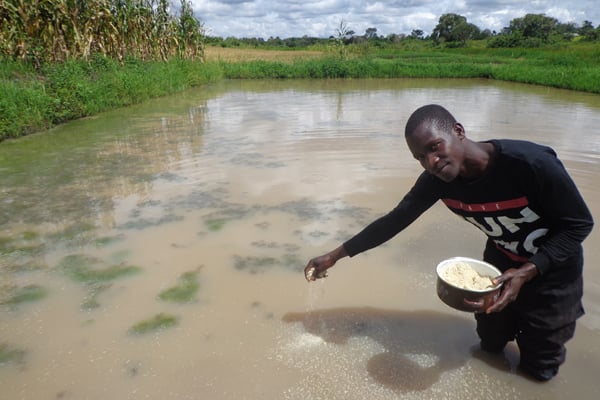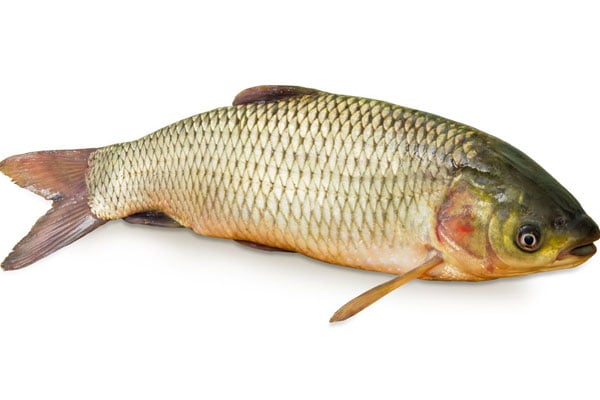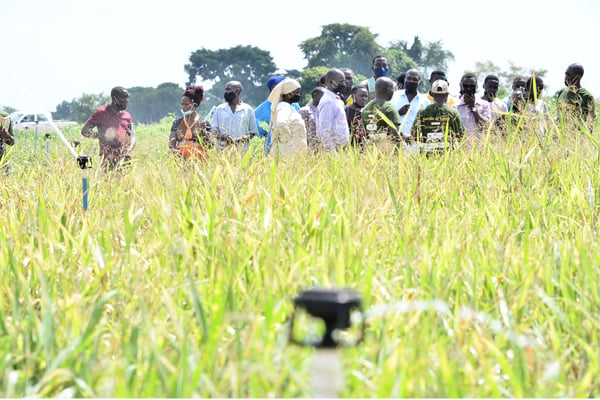Oyet cashing in on fish farming

Boniface Oyet feeding his fish in one of his ponds. He sees aquaculture as a way to ensure Uganda’s food security. Photo / Charity Akullo.
What you need to know:
- He was inspired into fish farming at the age of nine, while in Primary Three at St Paul School in Akalo, Kole District. At the time, he had just returned from an athletics competition in Kapchorwa District where he was inspired by a fish farmer. He says his mother gave him the heads up.
Boniface Oyet is reaping big from his fishery farm business after injecting Shs80,000 and devotedly labouring to grow the business.
He was inspired into fish farming at the age of nine, while in Primary Three at St Paul School in Akalo, Kole District. At the time, he had just returned from an athletics competition in Kapchorwa District where he was inspired by a fish farmer. He says his mother gave him the heads up.
“I decided to dig up a fish pond in 2000 and then visited my aunt who lives around Lake Kwania, who had promised to give me some fish to start the business,” Oyet recalls.
She then gave me six tilapia fish and five mud fish. But out of the six tilapia fish, two died. Only one mud fish survived. Oyet took care of the fish and sold them off to raise Shs80,000.
“When these fish matured, I decided to sell them off. The money I got motivated me to continue with the business. Since my parents could not raise my school fees, I dropped out of Primary Seven,” he says.
Between 2001 and 2004, Oyet dug a second pond which he stocked with more fish. The tilapia fish multiplied to 120 and the mud fish were 46. He sold off the stock and raised Shs480,000.
Five years later, he dug another pond from which he earned his first million shillings.
He used the Shs1.2m earned to venture into what he thought was lucrative rice farming. His first harvest was good as he got 12 bags, which he sold for Shs2.3m.
He re-invested the money into opening up a fourth fish pond. This time he paid for labour unlike in the past. He obtained another fish species from Abako Sub-County in Alebtong District locally named Chinese [Gilan]. Each of these species produces 7,000 fingerlings. After maturity, he sold them off ,raking in Shs3.6m.
Growth spurred him on and today he owns a big dam which he dug for Shs800,000.
The money generated from the fish farming has helped Oyet in constructing his own house, paying tuition for his children and his four siblings who are able to access education in good schools in Lira and Kampala.
The local community within Oyet’s home buys fish from him cheaply and during the dry season, neighbours fetch water for their animals.
Management
Oyet’s day begins as early as 6am, except for weekends, by feeding the fish. He attends meetings about fishing and also reaches out to potential clients.
He feeds his fish twice in a day at 10am and then at 4pm in the evening because during such times, the fingerlings will be playing on top of water.
“When taking feeds for my fish, I often move bare chest and hit the water with either a stick or cloth in order to notify them of my presence,” he added.
Besides his fish farming business, Oyet grows banana, maize and soya beans. ”The maize and soya beans help me in feeding the fish,” he says.
Oyet has planted 700 pine trees and 170 eucalyptuses to mitigate climatic change. He also has fruits like pawpaw, oranges, and mangoes, among others.
He has joined Kole Fish Farmers’ Cooperative Society where he gets skills and knowledge on how to manage his fishery business.
Oyet employs two workers who help him in the ponds whom he pays monthly; sometimes he uses his sons, most especially during holidays.
He keeps a complete record of his fish business including stock, total amount of money he spent in buying the fingerlings, feed and the sales. This helps him understand the profit and business operation.
Market
Combining tilapia in the same pond with the predatory Nile Perch balances the fish population.
Oyet realised that there is limited supply of fish in the market and a limited number of fish outlets compared to other protein sellers such as beef or poultry.
This fuelled his desire to seek markets to partly earn a living while also solving issues of undernutrition. He sells some of his fish to customers within his town and in neighboring districts. His main focus is Amach Market in Lira City.
Oyet now has seven ponds filled which makes him a happy farmer. On average, Oyet spends Shs700,000 for buying feeds for the tilapia fish. He reports an annual income of Shs8m from his ponds.
“Tilapia produces 7,000 fingerlings after six months. When it produces, fertility rates drop and as a result I stock new species,’’ he says.
Under natural conditions, tilapia starts to reproduce at a size of 20cm to 30cm. However, cultured fish reproduces at a much smaller size of 8-13cm or 20-40g.
To avoid stunting of fish, he works with extension workers to apply good husbandry techniques such as proper feeding rates and longer rearing periods.
Challenges
Oyet says because of the expense and scarcity of fingerlings, fish farmers like him have resorted to buying catfish caught by fishermen from swamps and other small water bodies to put in their ponds.
“I always find difficulties in getting the right qualities of fish species. Fish feed is also very expensive. This reduces the profit I get,” he says.
Oyet reveals that although there is a fish hatchery on Lira-Soroti Road, the quality of fingerlings is poor and its supply inconsistent because of its frequent breakdown.
He says the poor-quality fingerlings make them spend more on fish feeds, which are also expensive. 100kg of fish feeds which can last a month costs Shs295,000. This means if a farmer gets poor quality fingerlings, which take a year to mature, they need to spend additional Shs1.7m.
Dr Alfred Kumakech, a research officer at Naro, NgettaZardi, acknowledges that getting fish fingerlings has been the biggest challenge facing fish farmers, not only in the Lango sub-region but the whole of northern Uganda. He says they will soon embark on remodelling rundown hatcheries in northern Uganda to provide cheap fingerlings to farmers.
He adds that during the dry season, thieves often sneak in and steal fish.
Plan
Oyet is planning to buy a vehicle to ease transport issues to the market. Currently, he carries in sacks, which he fears reduces the quality.
Oyet advises farmers to stop the act of jealousy if in need of progressing.” If you are a farmer who wants to develop, create more friendship with your fellows, if possible visit their farms because it will help you acquire more knowledge and techniques they use that’s making them progressing,” he added.
There is also very limited information on aquaculture, especially the contribution of women and youth in aquaculture. I want to use my role to fix the information gap on aquaculture.
He says youth and women have little or no financial capacity to establish fish farms.




